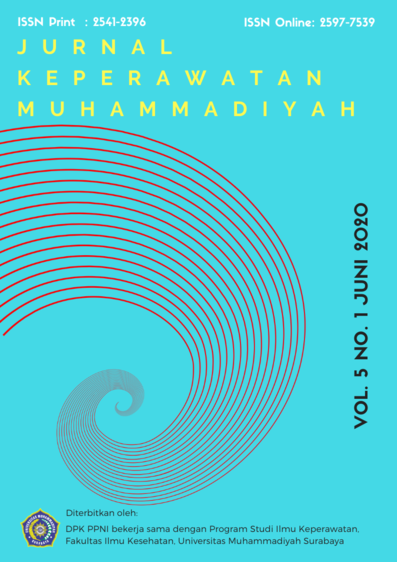Prevalensi dan Dampak Kecanduan Gadget Pada Remaja: Literature Review
DOI:
https://doi.org/10.30651/jkm.v5i1.4609Keywords:
Gadgets, Internet, Addiction, YouthAbstract
Objective: To know the prevalence and impact of gadgets addiction on youth. Method: The method utilized in this paper was a literature review of international journals conducted using the PubMed, ProQuest, Goggle Scholar database. At the initial stage of the search with the keywords: "((prevalence AND impact AND smartphone addiction OR internet addiction] AND adolescent))" it gained 14 international articles from the range of 2016 to 2018 which were in accordance with the inclusion and exclusion criteria.Results: From the 14 articles, there were 6 articles that discussed the prevalence of internet addiction 2 of which occurred in developed countries such as Japan and Taiwan, from the two countries the prevalence of internet addiction was 22.6% on average. Meanwhile, the prevalence in developing countries such as Turkey, Tunisia, China and India averaged 32.3%. Eight articles reviewed the effects of internet addiction. The impacts of using gadgets can be seen physically (Obesity) and psychologically [Depression, loneliness, suicide, sleep disturbance, attention deficit disorder and hyperactivity] and other impacts such as family dysfunction.Conclusion: The review of this literature review has gained the different prevalence of gadget and internet addiction between developed and developing countries in which the developed countries was 22.6% while developing countries was 32.3%. The impacts given of this addiction were the physical, psychological and family function impacts.
Â
Keywords: Gadgets, Internet, Addiction, Youth
References
Lau JTF, Gross DL, Wu AMS, Cheng K, Lau MMC. Incidence and predictive factors of Internet addiction among Chinese secondary school students in Hong Kong: a longitudinal study. Social Psychiatry and Psychiatric Epidemiology. 2017 Jun;52(6):657–67.
Diarti E, Sutriningsih A. HUBUNGAN ANTARA PENGGUNAAN INTERNET DENGAN GANGGUAN POLA TIDUR PADA MAHASISWA PSIK UNITRI MALANG. Nursing News. 2017;2:11.
Maulida R, Sari H. KAITAN INTERNET ADDICTION DAN POLA TIDUR PADA MAHASISWA FAKULTAS KEPERAWATAN. 2017;8.
So R, Makino K, Fujiwara M, Hirota T, Ohcho K, Ikeda S, et al. The Prevalence of Internet Addiction Among a Japanese Adolescent Psychiatric Clinic Sample With Autism Spectrum Disorder and/or Attention-Deficit Hyperactivity Disorder: A Cross-Sectional Study. Journal of Autism and Developmental Disorders. 2017 Jul;47(7):2217–24.
Wu J, Li T, Song X, Sun W. Prevalence and distribution of hypertension and related risk factors in Jilin Province, China 2015: a cross-sectional study. BMJ Open. 2018 Mar 1;8(3).
Mellouli M, Zammit N, Limam M, Elghardallou M, Mtiraoui A, Ajmi T, et al. Prevalence and Predictors of Internet Addiction among College Students in Sousse, Tunisia. 2017;7.
Seyrek S, Cop E, Sinir H, Ugurlu M, Şenel S. Factors associated with Internet addiction: Cross-sectional study of Turkish adolescents. Pediatrics International. 2017 Feb;59(2):218–22.
S. C. R, S. U. Prevalence and pattern of internet addiction among medical students, Bengaluru. International Journal Of Community Medicine And Public Health. 2017 Nov 23;4(12):4680.
Xin M, Xing J, Pengfei W, Houru L, Mengcheng W, Hong Z. Online activities, prevalence of Internet addiction and risk factors related to family and school among adolescents in China. Addictive Behaviors Reports. 2018 Jun;7:14–8.
Eliacik K, Bolat N, Koçyiğit C, Kanik A, Selkie E, Yilmaz H, et al. Internet addiction, sleep and health-related life quality among obese individuals: a comparison study of the growing problems in adolescent health. Eating and Weight Disorders - Studies on Anorexia, Bulimia and Obesity. 2016 Dec;21(4):709–17.
Gunay O, Ozturk A, Ergun Arslantas E, Sevinc N. Internet addiction and depression levels in Erciyes University students. Dusunen Adam: The Journal of Psychiatry and Neurological Sciences. 2018 Mar 30;31(1):79–88.
Parashkouh NN, Mirhadian L, EmamiSigaroudi A, Leili EK, Karimi H. Addiction to the Internet and mobile phones and its relationship with loneliness in Iranian adolescents. International Journal of Adolescent Medicine and Health [Internet]. 2018 Dec 4 [cited 2019 Feb 21];0(0). Available from: http://www.degruyter.com/view/j/ijamh.ahead-of-print/ijamh-2018-0035/ijamh-2018-0035.xml
Pan P-Y, Yeh C-B. Internet Addiction among Adolescents May Predict Self-Harm/Suicidal Behavior: A Prospective Study. The Journal of Pediatrics. 2018 Jun;197:262–7.
Panagiotidi M, Overton P. The relationship between internet addiction, attention deficit hyperactivity symptoms and online activities in adults. Comprehensive Psychiatry. 2018 Nov;87:7–11.
Chasanah AM, Kilis G. Adolescents’ Gadget Addiction and Family Functioning. In: Proceedings of the Universitas Indonesia International Psychology Symposium for Undergraduate Research (UIPSUR 2017) [Internet]. Depok, Indonesia: Atlantis Press; 2018 [cited 2019 Feb 21]. Available from: http://www.atlantis-press.com/php/paper-details.php?id=25899630
Nurdilla N, Elita V. HUBUNGAN KECANDUAN BERMAIN GAME ONLINE DENGAN KUALITAS TIDUR REMAJA. 2018;5(2):7.
Downloads
Published
Issue
Section
License
- Penulis tetap memegang hak atas karyanya dan memberikan hak publikasi pertama kepada jurnal ini yang secara simultan karya tersebut dilisensikan di bawah:Â Creative Commons Attribution-ShareAlike 4.0 International (CC BY-SA 4.0)













